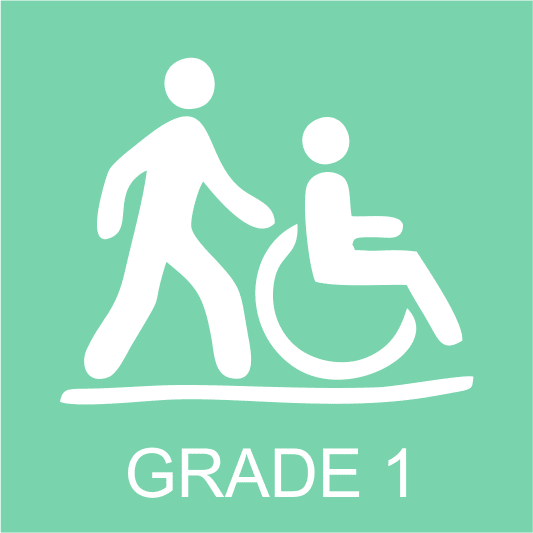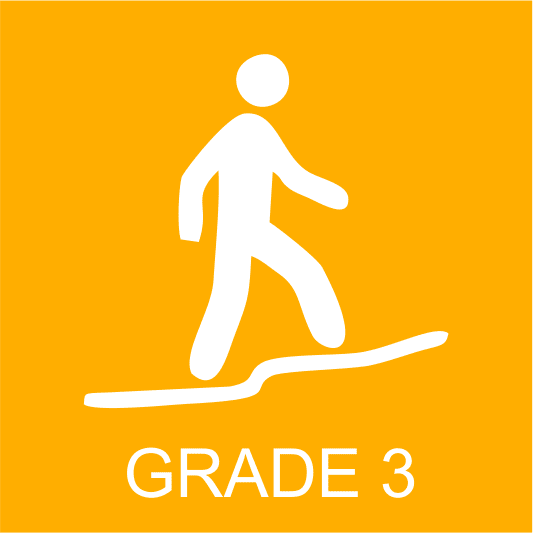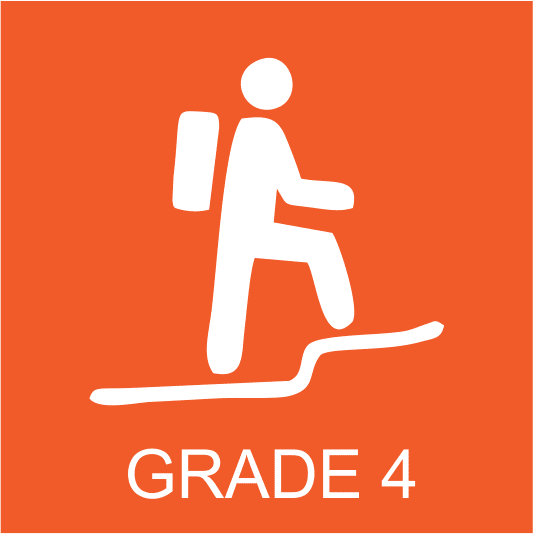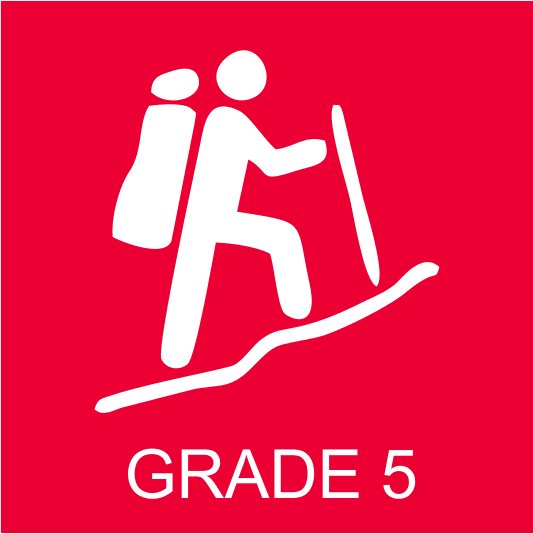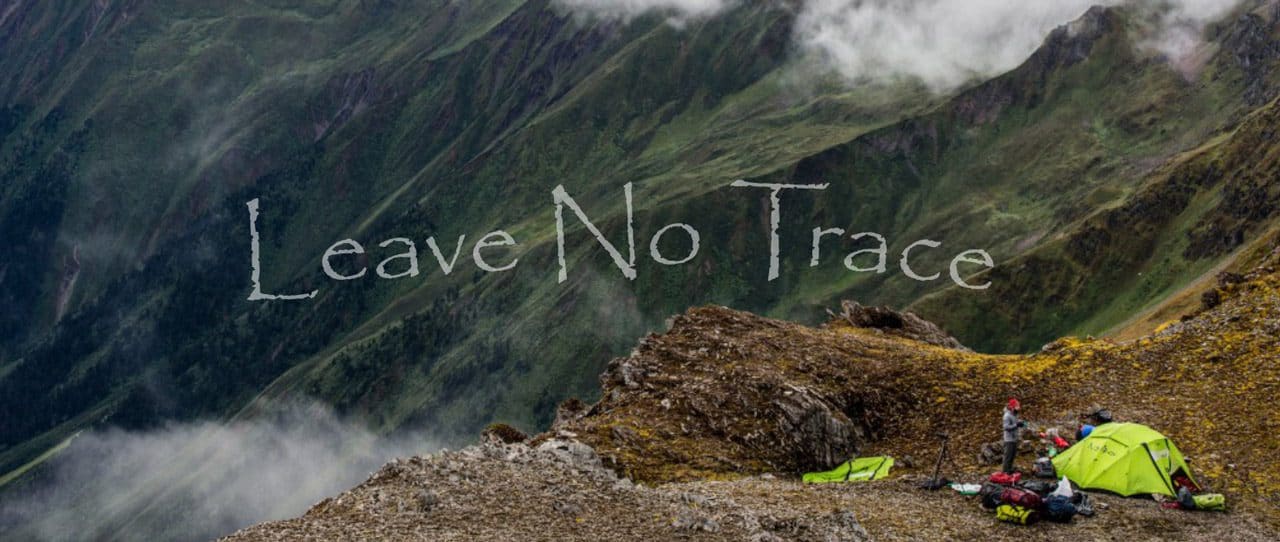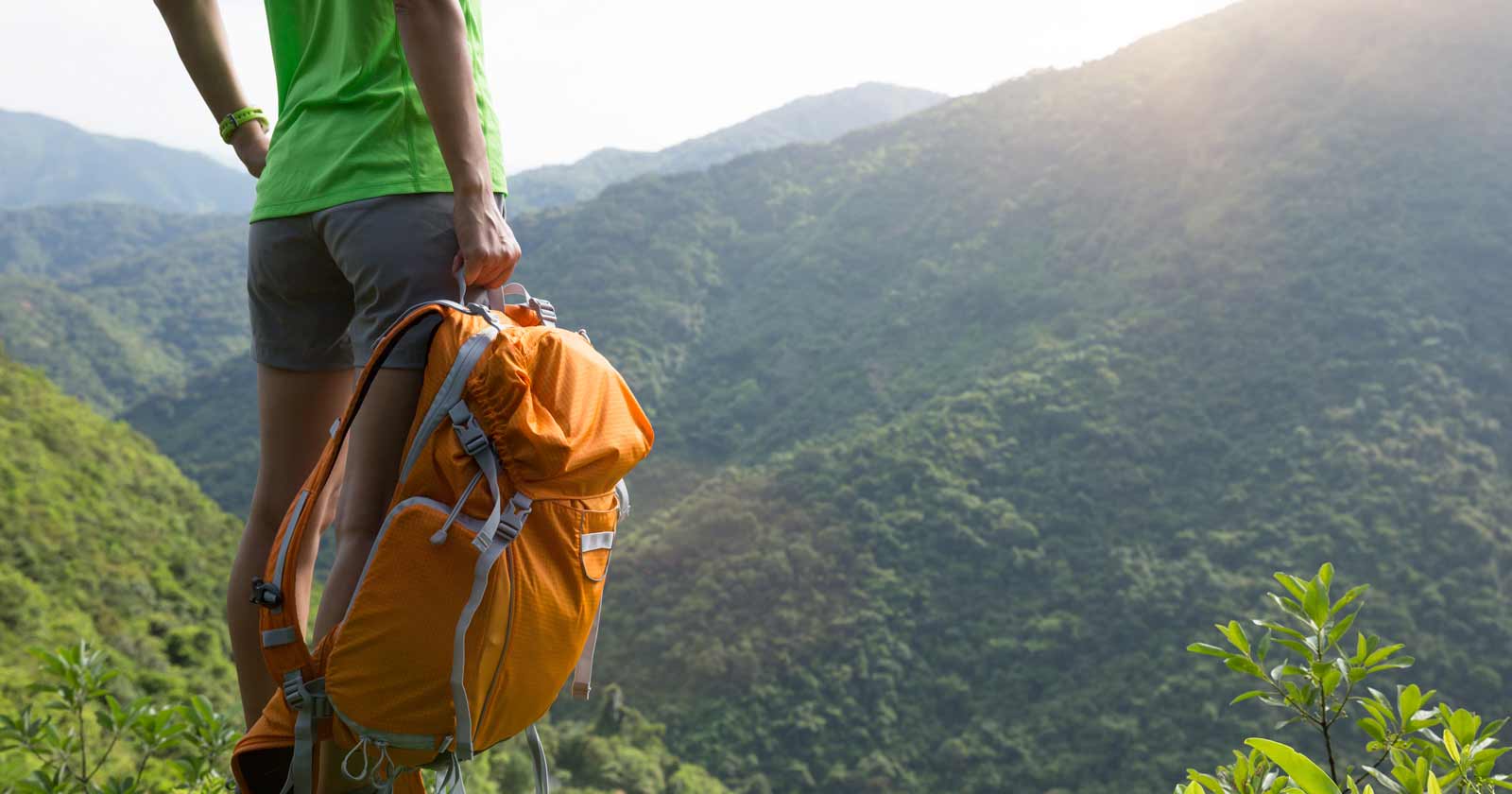Ever wondered if a walking track is right for you?
Ready to explore Australia’s breathtaking trails, but worried you might pick one that’s too challenging (or too easy)? While online platforms and apps can be a great resource for finding hikes, user-generated content (UGC) often lacks consistent guidelines for rating difficulty. This can make it tricky to gauge if a trail is a good fit for your experience level, potentially putting you at risk if the hike is more challenging or longer than expected.
Choosing the perfect walking track in Australia can be tricky, especially for new bushwalkers. Difficulty ratings based on user-generated content can be subjective and misleading. That’s where the Australian Walking Track Grading System (AWTGS) comes in. This handy system tackles this exact concern by providing a clear and objective 5-grade scale (1-5) for walks across the country.
The AWTGS grades walks based on their most challenging aspect, ensuring you’re prepared for the toughest section of the trail. Descriptions aim to accurately depict the entire walking experience. But what exactly do these grades mean? This post will break down each grade in detail, equipping you with the decision-making tools you need to confidently explore Australia’s amazing trails.
Decoding the Australian Walking Track Grading System: A User-Friendly Guide
To help you choose the right hike, let’s take a closer look at the AWTGS grading system. The following table provides a quick and easy reference for each grade, using a side-by-side comparison.
Australian Walking Track Grading System: At-a-Glance
| Grade of Walk | Grade 1 | Grade 2 | Grade 3 | Grade 4 | Grade 5 |
| Distance (km) | Up to 5 | Up to 10 | Up to 20 | – | – |
| Gradient | Flat | Gentle hills | Short steep hills | Very steep | Very steep / difficult |
| Quality of Track | Well formed | Formed | Formed with obstacles | Rough with obstacles | Rough & unformed |
| Quality of Signs and markers | Clear | Clear | Some | Limited | None |
| Experience Required | No experience | No experience | Some experience | Experienced | Very experienced |
| Steps | No steps | Occasional steps | Many steps | – | – |
Considering Distance: While the AWTGS considers various factors like terrain, path quality, and experience, distance plays a significant role, particularly in Grades 1-3. A seemingly easy track can be classified as Grade 3 simply because it’s a long walk (up to 20km). Distance is a crucial factor because it impacts overall exertion. A longer walk, even on flat terrain, requires greater stamina and endurance compared to a shorter track. The AWTGS is a standardised system, but it can’t capture every detail. A 15km, flat Grade 3 track might be easier than a 5km Grade 3 track with steep sections. This is where personal fitness and experience come into play. For a deeper dive into the limitations of distance-based grading, check out my separate blog post that explores these nuances in more detail.
Decoding the Grades in Detail
Now that you have a handy reference for the AWTGS grades, let’s dive deeper. This section provides detailed breakdowns, directly from the AWTGS, to give you a comprehensive understanding of the criteria used to classify walking tracks. We’ll start with Grade 1 and progress through each level, highlighting the key factors that influence the difficulty rating.
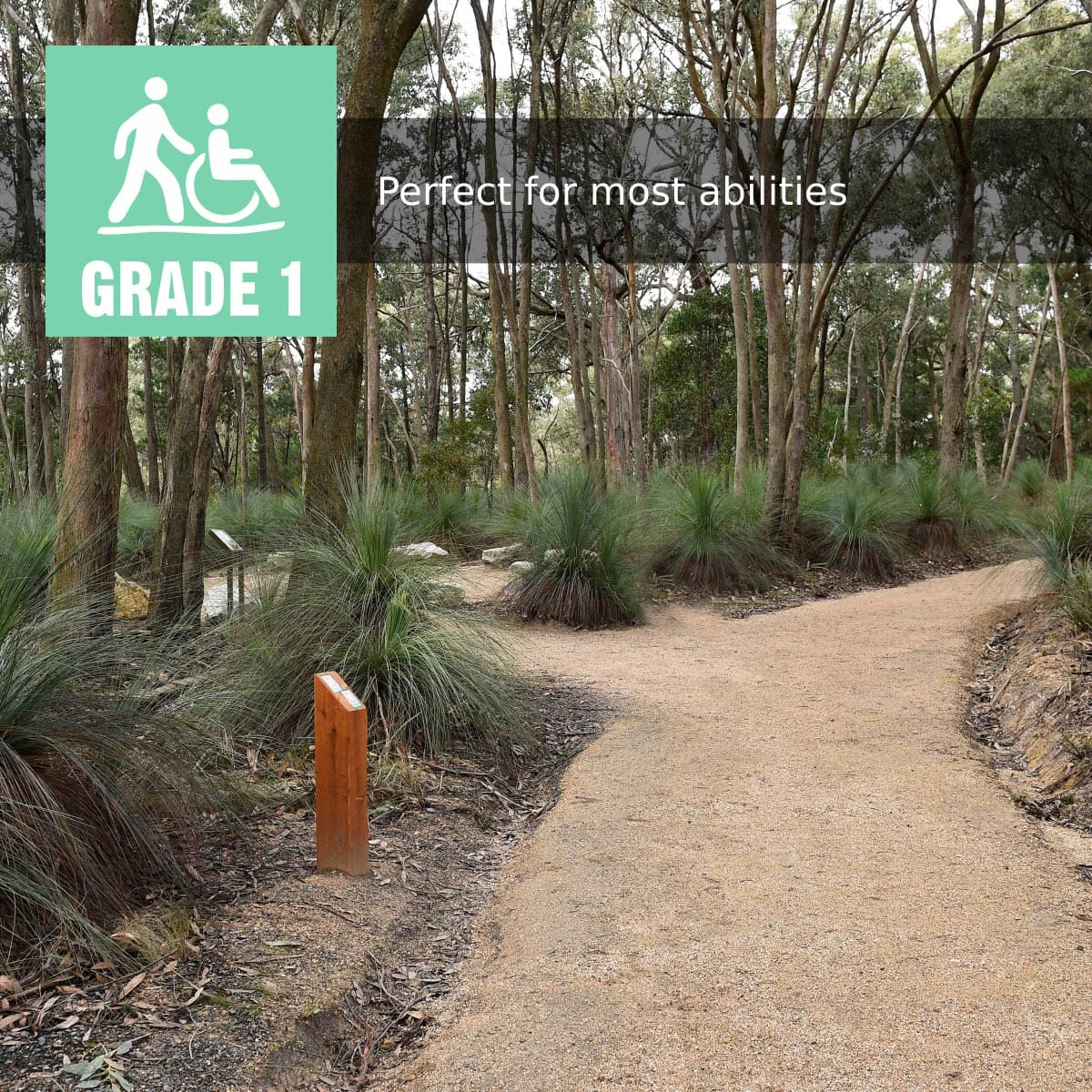
Grade 1 (All-abilities)*
Perfect for Families and Beginners: Grade 1 on the AWTGS represents the easiest walking tracks, perfect for families with young children or those new to bushwalking. No prior experience is required.
These gentle walks feature a flat, even surface with no steps or steep sections. They are suitable for wheelchair users with assistance due to the even terrain. The total distance of a Grade 1 walk is typically no greater than 5 kilometers, making them a comfortable and manageable option for all ages and fitness levels.
Let’s look at the specific details that define a Grade 1 walking track according to the AWTGS:
| GRADE 1 WALK | Technical Description for Land Manager use | Walk Description for Public Information | Generic Description for Public Information |
| Distance | Total distance of track must not exceed 5km. | Total distance of track to nearest 100 metre (eg 4.2km). | No bushwalking experience required. Flat even surface with no steps or steep sections. Suitable for wheelchair users who have someone to assist them. Walks no greater than 5km.
|
| Gradient | Grades in accordance with the AS 1428 series. (AS 2165.1) A ramp at 1:14 (7.14% slope or 4.1degrees) is the maximum slope/gradient suitable for a person in a wheelchair. | Flat. | |
| Quality of path | Broad, hard surfaced track of path suitable for wheelchair use. Width: 1200mm or more. Well maintained with minimal intrusions. (AS 2165.1) | Well formed track. | |
| Quality of markings | Track head signage and route markers at intersections. | Clearly sign posted. | |
| Experience required | Users need no previous experience and are expected to exercise normal care regarding their personal safety. (AS 2165.1) | No experience required. | |
| Time | 30 minute increments (eg 1-1.5hr) or if the predicted time is less than an hour in 15 minute increments (eg 30-45 minutes). | Time needed to complete track to nearest half hour or nearest 15 minute increment (eg 1-1.5 hours or 30-45 minutes). | |
| Steps | Steps allowed only with alternate ramp access. (AS 2165.1) | No steps. | |
| A Grade 1 walk corresponds to AS 2165.1 Class 1 track | |||
*Accessibility Considerations
The AWTGS is a great tool for understanding the general difficulty of a walking track, but it doesn’t encompass all aspects of accessibility. While Grade 1 tracks are often suitable for families with young children and those new to bushwalking, and the descriptor refers to suitability for wheelchairs, it’s important to remember that the AWTGS primarily focuses on walking difficulty and may not consider all accessibility features.
A truly accessible walking track caters to a wider range of abilities, including those using wheelchairs, walking sticks, or other mobility aids. Accessibility considerations encompass various factors beyond just the walking surface, such as:
- Footpath width: Wide enough to comfortably accommodate wheelchairs or walkers.
- Track surface: Firm, stable, and free of obstacles for wheelchairs and walkers.
- Accessible parking: Designated parking spots close to the trailhead.
- Accessible toilets: Accessible toilet facilities along the track or at the trailhead.
- Grade: A gentle incline to minimize exertion for those using mobility aids.
- Crossing the road: Safe and accessible crossings for those using mobility aids.
- Traffic: Minimal traffic on or near the walking track.
- Safety: Clear signage, emergency call points, and well-maintained surfaces.
- Aesthetics: A pleasant and enjoyable environment for all users.
Finding Accessible Trails: For those seeking truly accessible trails, it’s important to consult resources that specifically cater to accessibility needs. Many government websites and park authorities provide listings of accessible walking tracks with detailed information about the features mentioned above.
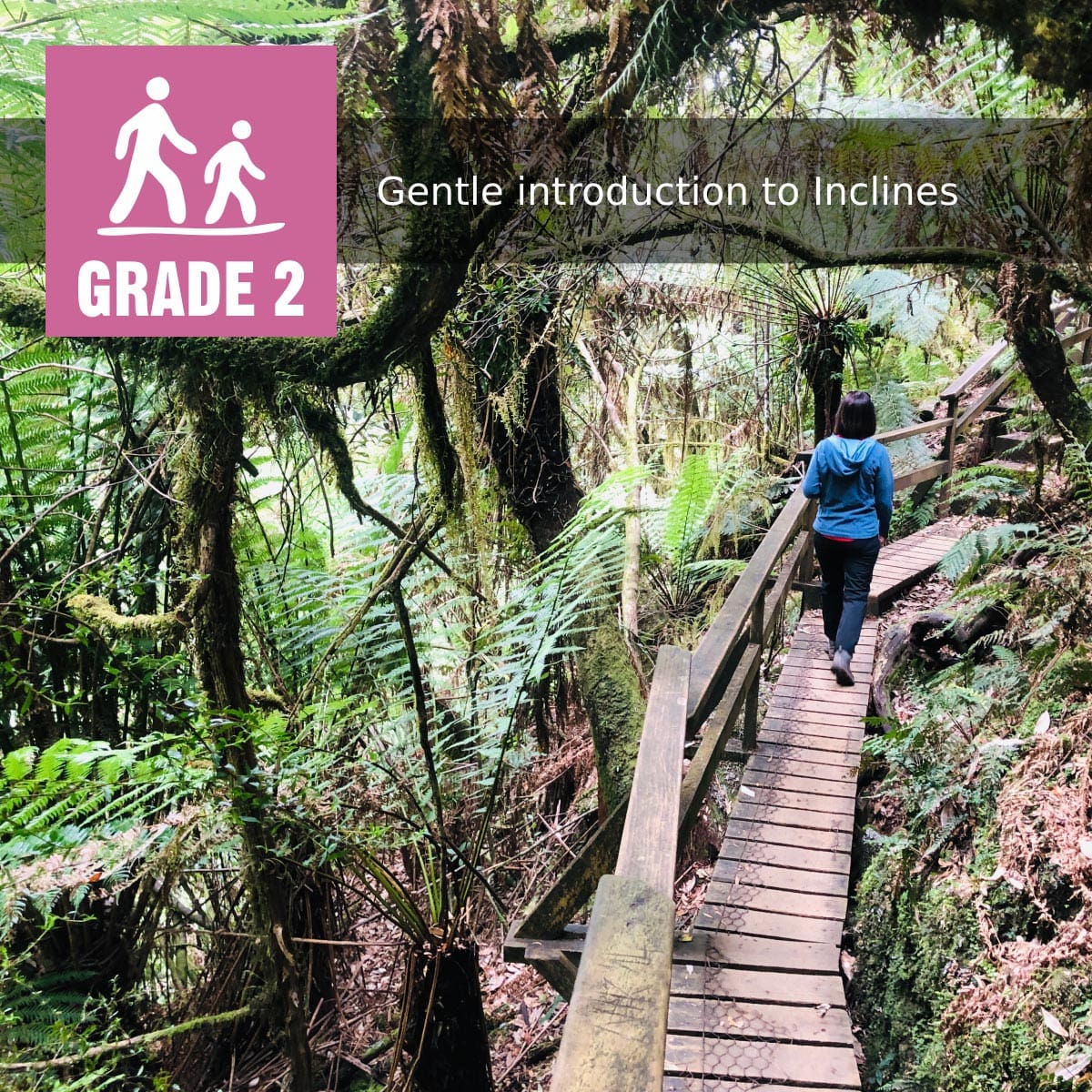
Grade 2 (Easy)
A Gentle Introduction to Inclines: Moving on to Grade 2 on the AWTGS, these walking tracks offer a slightly more challenging experience compared to Grade 1. Similar to Grade 1, no prior bushwalking experience is required.
The track surface is typically hardened or compacted and may have gentle hill sections or occasional steps. The total distance of a Grade 2 walk is typically no greater than 10 kilometers. These walks are still suitable for families with a bit more experience or those seeking a gentle introduction to some inclines.
Let’s explore the specific criteria that define a Grade 2 walking track according to the AWTGS:
| GRADE 2 WALK | Technical Description for Land Manager use | Walk Description for Public Information | Generic Description for Public Information |
| Distance | Total distance of track must not exceed 10km. | Total distance of track to nearest 100 metre (eg 4.2km). | No bushwalking experience required. The track is a hardened or compacted surface and may have a gentle hill section or sections and occasional steps. Walks no greater than 10km.
|
| Gradient | The gradient is generally no steeper than 1:10 (or 10% or 5.7 degrees). (AS 2165.1). | Gentle hills. | |
| Quality of path | Generally a modified or hardened surface. Width: 900mm or more. Well maintained with minimal intrusions. (AS 2165.1). | Formed track. | |
| Quality of markings | Track head signage & route markers at intersections. | Clearly sign posted. | |
| Experience required | Users need no previous experience and are expected to exercise normal care regarding their personal safety. (AS 2165.1). Suitable for most ages and fitness levels. | No experience required. | |
| Time | 30 minute increments Time needed to complete (eg 1.5-2hrs) or if the predicted time is less than an hour in 15 minute increments (eg 30-45 minutes). | Time needed to complete track to nearest half hour or nearest 15 minute increment (eg 1-1.5hrs or 30-45 minutes). | |
| Steps | Minimal use of steps. (AS 2165.1). | Occasional steps. | |
| A Grade 2 walk corresponds to AS 2165.1 Class 2 track | |||

Grade 3 (Moderate)
Moderate Walks for Most Fitness Levels: Grade 3 on the AWTGS represents moderate walking tracks. These are ideal for walkers with some fitness who are comfortable with some hills and uneven terrain.
While suitable for most ages, some bushwalking experience is recommended to ensure a safe and enjoyable experience. Tracks may have short, steep hill sections, a rough surface, and many steps. The total distance of a Grade 3 walk can be up to 20 kilometers.
Let’s dive into the details that define a Grade 3 walking track according to the AWTGS:
| GRADE 3 WALK | Technical Description for Land Manager use | Walk Description for Public Information | Generic Description for Public Information |
| Distance | Total distance of track must not exceed 20km. | Total distance of track to nearest 100 metre (eg 4.2km). | Suitable for most ages and fitness levels. Some bushwalking experience recommended. Tracks may have short steep hill sections a rough surface and many steps. Walks up to 20km.
|
| Gradient | May exceed 1:10 (or 10% or 5.7 degrees) for short sections but generally no steeper than 1:10. (AS 2165.1). | Short steep hills. | |
| Quality of path | Formed earthen track, few obstacles. Generally a modified surface, sections may be hardened. Width: variable and less than 1200mm. Kept mostly clear of intrusions and obstacles. (AS 2165.1). | Formed track, some obstacles. | |
| Quality of markings | Track head signage and route markers at intersections and where track is indistinct. | Sign posted. | |
| Experience required | Users need no bushwalking experience and a minimum level of specialised skills. Users may encounter natural hazards such as steep slopes, unstable surfaces and minor water crossings. They are responsible for their own safety. (AS 2165.1). | Some bushwalking experience recommended. | |
| Time | Hours/days (eg 9hrs) or if the predicted time is less than an hour in 15 minute increments. (eg 45 minutes). | Hours/days or if the predicted time is less than an hour in 15 minute increments. | |
| Steps | Steps may be common. (AS 2165.1). | Many steps. | |
| A Grade 3 walk corresponds to AS 2165.1 Class 3 track | |||

Grade 4 (Hard)
Challenging Walks for Experienced Walkers: Grade 4 on the AWTGS signifies challenging walking tracks. Bushwalking experience is recommended for these tracks, which may be long, rough, and very steep.
Directional signage may be limited, requiring a good sense of navigation. These walks are suited for experienced walkers who are comfortable with steeper inclines, rougher terrain, and potentially longer distances.
Let’s explore the specific criteria that define a Grade 4 walking track according to the AWTGS:
| GRADE 4 WALK | Technical Description for Land Manager use | Walk Description for Public Information | Generic Description for Public Information |
| Distance | Total distance of track may be greater than 20km. Distance does not influence grading. | Total distance of track to nearest km. | Bushwalking experience recommended. Tracks may be long, rough and very steep. Directional signage may be limited.
|
| Gradient | May have arduous climbs and steep sections. May include long steep sections exceeding 1:10. | Very steep. | |
| Quality of path | Generally distinct without major modification to the ground. Encounters with fallen debris and other obstacles are likely. (AS 2165.1) Walkers may encounter natural obstacles (eg tides). | Rough track, many obstacles. | |
| Quality of markings | Track head signage and route markers. | Limited signage. | |
| Experience required | Users require a moderate level of specialised skills such as navigation skills. Users may require maps and navigation equipment to successfully complete the track. Users need to be self-reliant, particularly in regard to emergency first aid and possible weather hazards. (AS 2165.1). | Eexperience bushwalkers. | |
| Time | Hours/days (eg 9hrs) or if the predicted time is less than an hour in 15 minute increments (eg 45 minutes). | Hours/days or if the predicted time is less than an hour 15 minute increments. | |
| Steps | Steps N/A (AS 2165.1) Steps do not influence grading. | – | |
| A Grade 4 walk corresponds to AS 2165.1 Class 4 track | |||
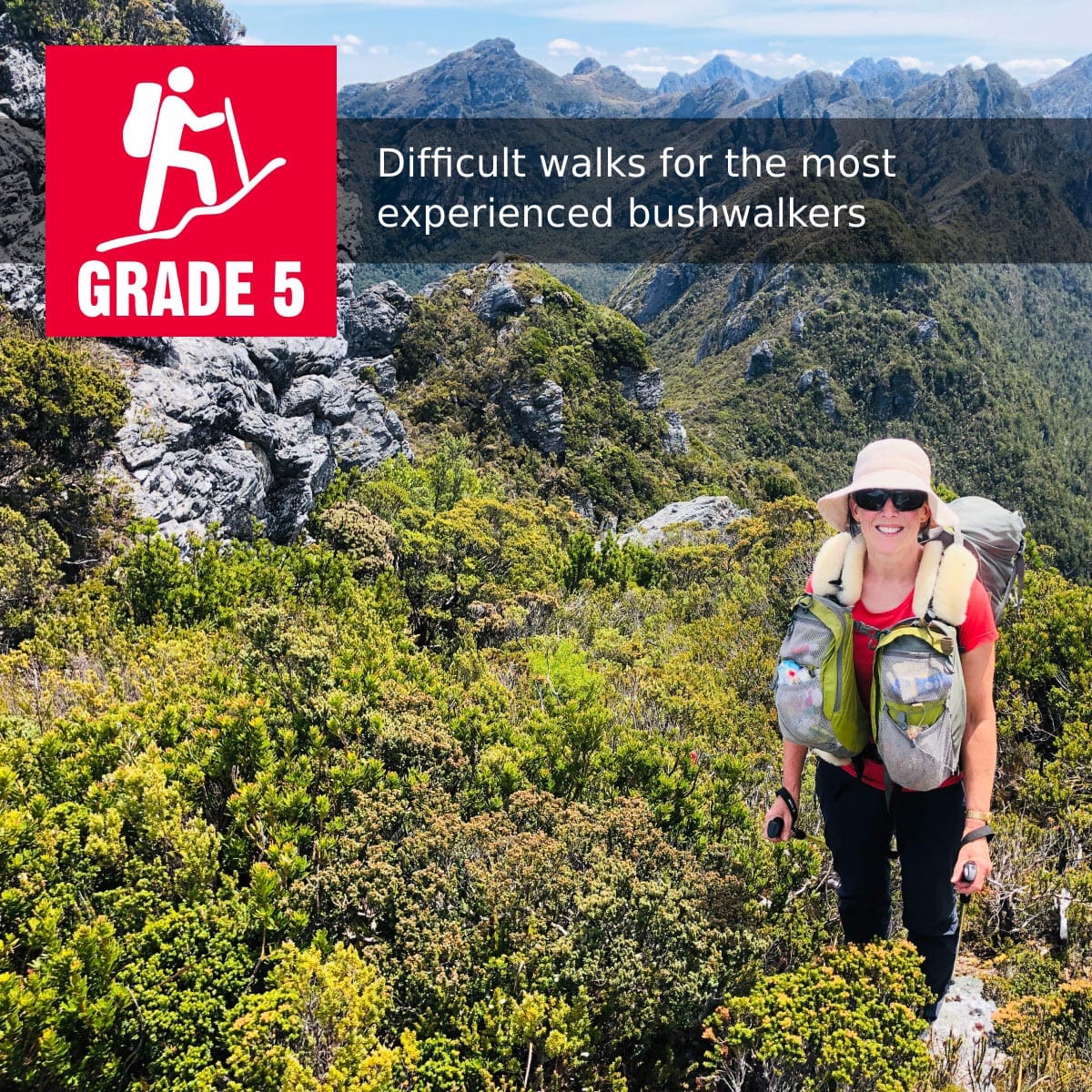
Grade 5 (Difficult)
Walks for the Most Experienced: Grade 5 on the AWTGS represents the most challenging walking tracks on the AWTGS. These are only recommended for very experienced and fit walkers with specialised skills, including navigation and emergency first aid.
Tracks are likely to be very rough, very steep, and unmarked. Walks may be more than 20 kilometers. These challenging walks demand a high level of fitness and experience to navigate difficult terrain, significant elevation changes, and potentially unformed paths.
Let’s break down the details that define a Grade 5 walking track according to the AWTGS:
| GRADE 5 WALK | Technical Description for Land Manager use | Walk Description for Public Information | Generic Description for Public Information |
| Distance | Total distance of track may be greater than 20km. Distance does not influence grading. | Total distance of track to nearest km. | Very experienced bushwalkers with specialised skills, including navigation and emergency first aid. Tracks are likely to be very rough, very steep and unmarked. Walks may be more than 20km.
|
| Gradient | May have very arduous climbs and steep sections. May include long steep sections exceeding 1:10. | Very steep and difficult. | |
| Quality of path | No modification of the natural environment. (AS 2165.1). | Rough unformed track. | |
| Quality of markings | Signage is generally not provided. (AS 2165.1). | No directional signage. | |
| Experience required | Users require previous experience in the outdoors and a high level of specialised skills such as navigation skills. Users will generally require a map and navigation equipment to complete the track. Users need to be self-reliant, particularly in regard to emergency first aid and possible weather hazards. (AS 2165.1). | Very experienced bushwalkers. | |
| Time | Time Hours/days. | Hours/days. | |
| Steps | N/A (AS 2165.1). Steps do not influence grading. | – | |
| A Grade 5 walk corresponds to AS 2165.1 Class 5 & 6 track | |||
Before You Hit the Trail: A Look Beyond the AWTGS Grading System
The AWTGS empowers you to choose hikes that align with your abilities. However, it’s important to remember that the AWTGS is just your first step. Many factors can influence the difficulty of a hike beyond the AWTGS grade.
Plan for a Safe and Enjoyable Adventure: While the AWTGS provides a solid foundation, remember to explore additional considerations before hitting the trail. Be honest with yourself about your experience and physical capabilities. Choose a trail that matches your fitness level, like opting for Grades 2-3 if you’re new to hiking. There’s always another trail waiting to be explored when you’re ready.
Reliable Resources are Key: Check maps and official sources where routes are verified, graded, accurate, and up-to-date. Websites with verified data provide detailed information on specific trails, including distance, elevation gain, estimated duration, track conditions, and amenities. While apps are great for getting ideas about tracks and spots to explore, they should never be wholly relied upon for navigation. These apps can be user-generated and may not be officially verified by the land manager (like National Parks) and might not include the Australian Walking Track Grade.
For a deeper dive into factors beyond the AWTGS, check out: Australian Walking Track Grading: A look beyond the numbers.
To access the official AWTGS User Guide for even more details, click here.
